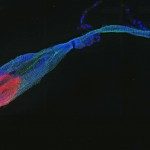Link to Pubmed [PMID] – 8756690
Biochemistry 1996 Aug;35(32):10347-57
The annexin fold consists of four 70-residue domains with markedly homologous sequences and nearly identical structures. Each domain contains five helices designated A to E. Domain 2 of annexin I was obtained by chemical synthesis including ten specifically labeled residues and studied by 1H-15N NMR and circular dichroism (CD). In pure aqueous solution this annexin domain presents, at most, 25% of residual helix secondary structure compared to 75%-85% for the native helix content and thus does not constitute an autonomous folding unit. Dodecylphosphocholine (DPC) micelles were used to provide the annexin domain with non-specific hydrophobic interactions. The structuring effect of micelles was thoroughly investigated by CD and 1H-15N NMR. Most, but not all, of the native helix secondary structure was recovered at DPC saturation. NMR data made it possible to determine the intrinsic helix propensity hierarchy of the different helix segments of the domain: A approximately B approximately E > C, D. This hierarchy is remarkably well correlated with the location of the helices in the native protein since A, B, and E helices are those in contact with the remaining parts of the protein. This result tends to support the view that, for large proteins like annexins (35 kDa), high intrinsic secondary structure propensities, at least helix propensity, in selected protein segments is necessary for a correct folding process. As a consequence this also indicates that important information concerning the folding pathway is encoded in the protein sequence.

